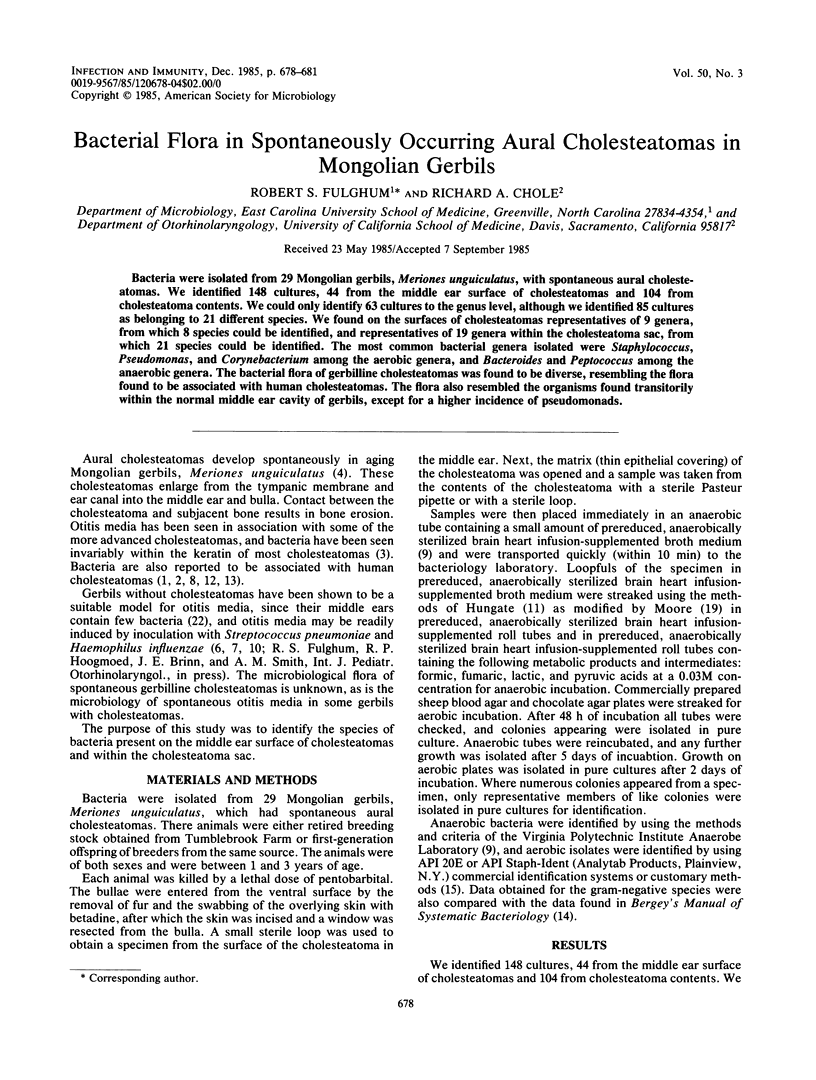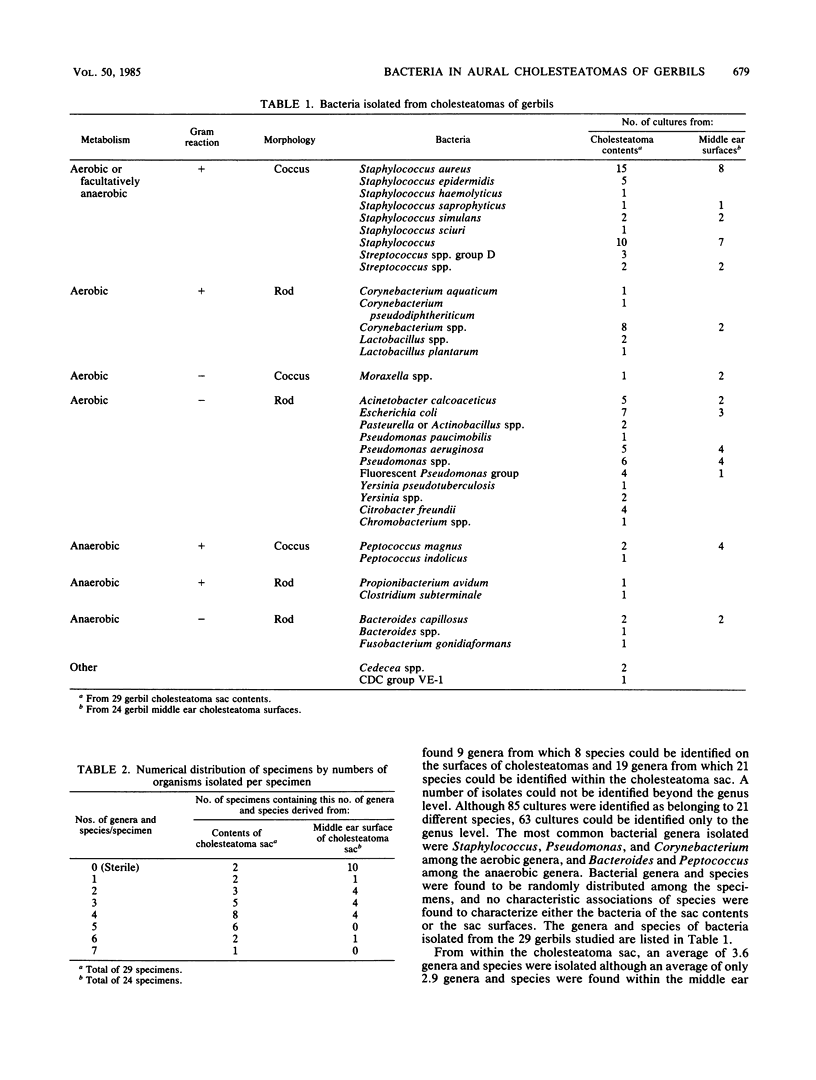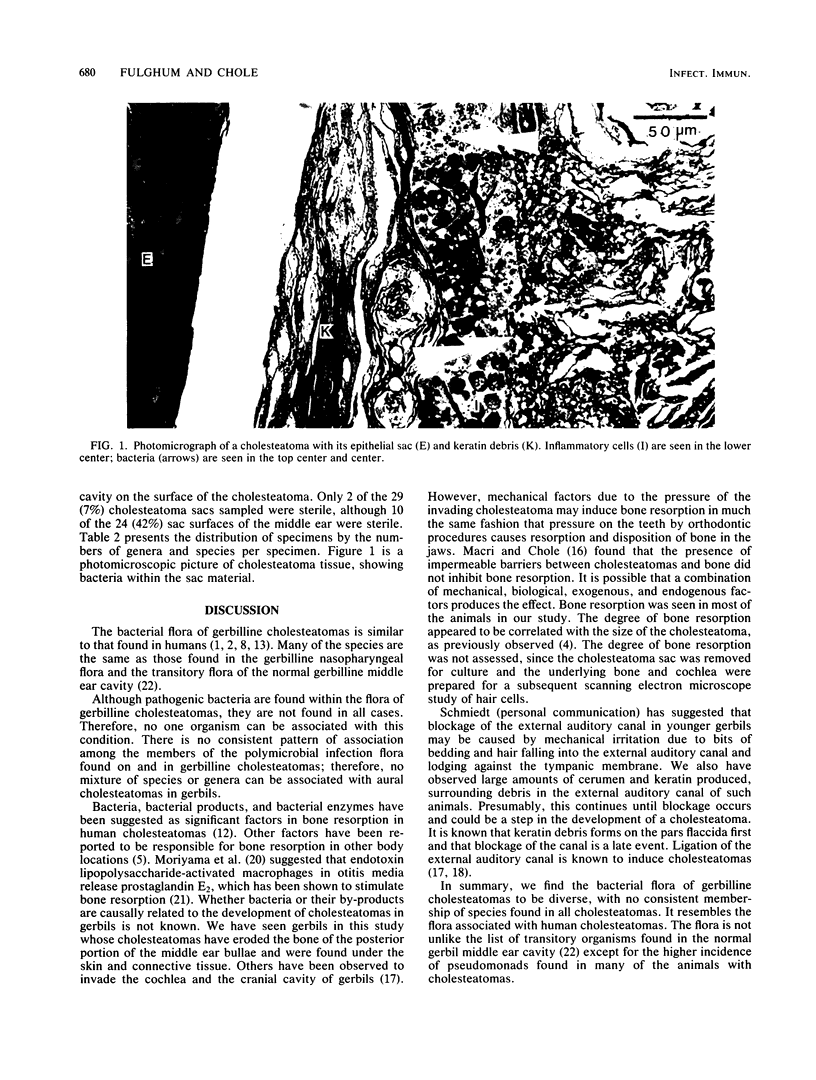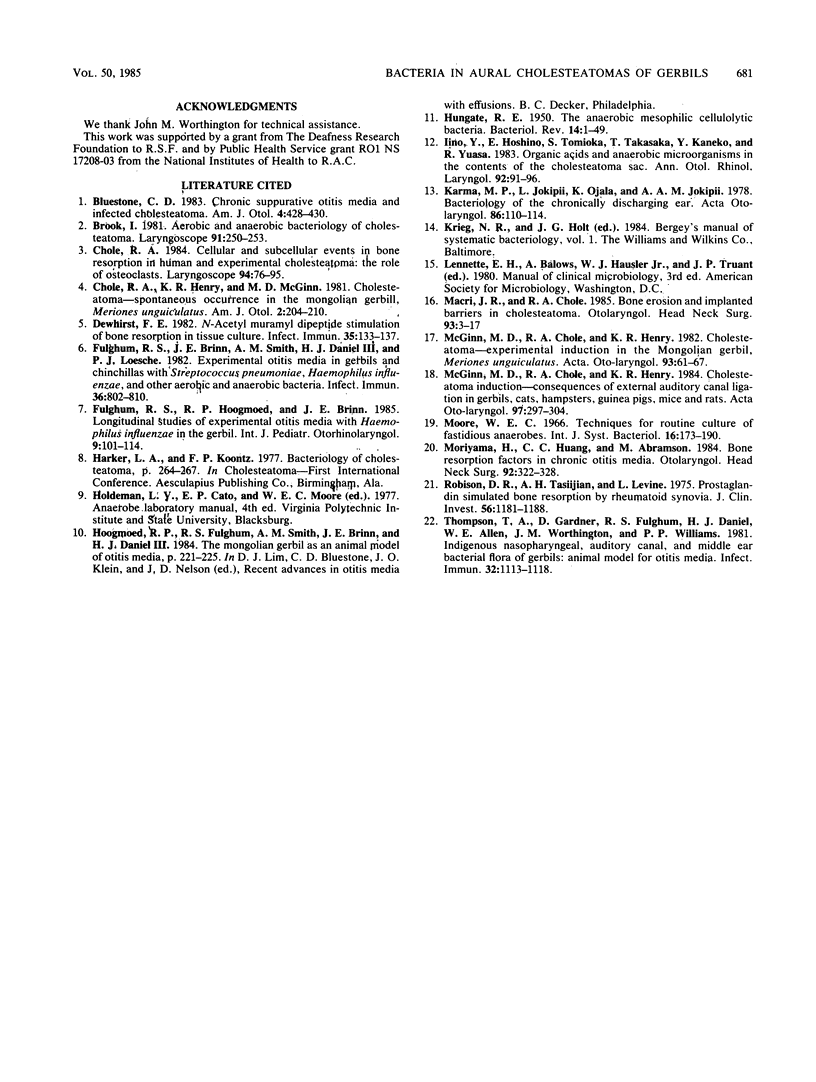Abstract
Bacteria were isolated from 29 Mongolian gerbils, Meriones unguiculatus, with spontaneous aural cholesteatomas. We identified 148 cultures, 44 from the middle ear surface of cholesteatomas and 104 from cholesteatoma contents. We could only identify 63 cultures to the genus level, although we identified 85 cultures as belonging to 21 different species. We found on the surfaces of cholesteatomas representatives of 9 genera, from which 8 species could be identified, and representatives of 19 genera within the cholesteatoma sac, from which 21 species could be identified. The most common bacterial genera isolated were Staphylococcus, Pseudomonas, and Corynebacterium among the aerobic genera, and Bacteroides and Peptococcus among the anaerobic genera. The bacterial flora of gerbilline cholesteatomas was found to be diverse, resembling the flora found to be associated with human cholesteatomas. The flora also resembled the organisms found transitorily within the normal middle ear cavity of gerbils, except for a higher incidence of pseudomonads.
Full text
PDF



Images in this article
Selected References
These references are in PubMed. This may not be the complete list of references from this article.
- Bluestone C. D. Chronic suppurative otitis media and infected cholesteatoma. Am J Otolaryngol. 1983 Nov-Dec;4(6):428–430. doi: 10.1016/s0196-0709(83)80055-6. [DOI] [PubMed] [Google Scholar]
- Brook I. Aerobic and anaerobic bacteriology of cholesteatoma. Laryngoscope. 1981 Feb;91(2):250–253. doi: 10.1288/00005537-198102000-00012. [DOI] [PubMed] [Google Scholar]
- Chole R. A. Cellular and subcellular events of bone resorption in human and experimental cholesteatoma: the role of osteoclasts. Laryngoscope. 1984 Jan;94(1):76–95. doi: 10.1002/lary.5540940117. [DOI] [PubMed] [Google Scholar]
- Chole R. A., Henry K. R., McGinn M. D. Cholesteatoma: spontaneous occurrence in the Mongolian gerbil Meriones unguiculatis. Am J Otol. 1981 Jan;2(3):204–210. [PubMed] [Google Scholar]
- Dewhirst F. E. N-acetyl muramyl dipeptide stimulation of bone resorption in tissue culture. Infect Immun. 1982 Jan;35(1):133–137. doi: 10.1128/iai.35.1.133-137.1982. [DOI] [PMC free article] [PubMed] [Google Scholar]
- Fulghum R. S., Brinn J. E., Smith A. M., Daniel H. J., 3rd, Loesche P. J. Experimental otitis media in gerbils and chinchillas with Streptococcus pneumoniae, Haemophilus influenzae, and other aerobic and anaerobic bacteria. Infect Immun. 1982 May;36(2):802–810. doi: 10.1128/iai.36.2.802-810.1982. [DOI] [PMC free article] [PubMed] [Google Scholar]
- Fulghum R. S., Hoogmoed R. P., Brinn J. E. Longitudinal studies of experimental otitis media with Haemophilus influenzae in the gerbil. Int J Pediatr Otorhinolaryngol. 1985 Jul;9(2):101–114. doi: 10.1016/s0165-5876(85)80010-0. [DOI] [PubMed] [Google Scholar]
- HUNGATE R. E. The anaerobic mesophilic cellulolytic bacteria. Bacteriol Rev. 1950 Mar;14(1):1–49. doi: 10.1128/br.14.1.1-49.1950. [DOI] [PMC free article] [PubMed] [Google Scholar]
- Iino Y., Hoshino E., Tomioka S., Takasaka T., Kaneko Y., Yuasa R. Organic acids and anaerobic microorganisms in the contents of the cholesteatoma sac. Ann Otol Rhinol Laryngol. 1983 Jan-Feb;92(1 Pt 1):91–96. doi: 10.1177/000348948309200122. [DOI] [PubMed] [Google Scholar]
- Karma P., Jokippi L., Ojala K., Jokipii A. M. Bacteriology of the chronically discharging middle ear. Acta Otolaryngol. 1978 Jul-Aug;86(1-2):110–114. doi: 10.3109/00016487809124726. [DOI] [PubMed] [Google Scholar]
- Macri J. R., Chole R. A. Bone erosion in experimental cholesteatoma--the effects of implanted barriers. Otolaryngol Head Neck Surg. 1985 Feb;93(1):3–17. doi: 10.1177/019459988509300102. [DOI] [PubMed] [Google Scholar]
- McGinn M. D., Chole R. A., Henry K. R. Cholesteatoma induction. Consequences of external auditory canal ligation in gerbils, cats, hamsters, guinea pigs, mice and rats. Acta Otolaryngol. 1984 Mar-Apr;97(3-4):297–304. doi: 10.3109/00016488409130992. [DOI] [PubMed] [Google Scholar]
- McGinn M. D., Chole R. A., Henry K. R. Cholesteatoma. Experimental induction in the Mongolian Gerbil, Meriones Unguiculaus. Acta Otolaryngol. 1982 Jan-Feb;93(1-2):61–67. doi: 10.3109/00016488209130853. [DOI] [PubMed] [Google Scholar]
- Moriyama H., Huang C. C., Abramson M., Kato M. Bone resorption factors in chronic otitis media. Otolaryngol Head Neck Surg. 1984 Jun;92(3):322–328. doi: 10.1177/019459988409200315. [DOI] [PubMed] [Google Scholar]
- Robinson D. R., Tashjian A. H., Jr, Levine L. Prostaglandin-stimulated bone resorption by rheumatoid synovia. A possible mechanism for bone destruction in rheumatoid arthritis. J Clin Invest. 1975 Nov;56(5):1181–1188. doi: 10.1172/JCI108195. [DOI] [PMC free article] [PubMed] [Google Scholar]
- Thompson T. A., Gardner D., Fulghum R. S., Daniel H. J., Allen W. E., Worthington J. M., Williams P. P. Indigenous nasopharyngeal, auditory canal, and middle ear bacterial flora of gerbils: animal model for otitis media. Infect Immun. 1981 Jun;32(3):1113–1118. doi: 10.1128/iai.32.3.1113-1118.1981. [DOI] [PMC free article] [PubMed] [Google Scholar]



